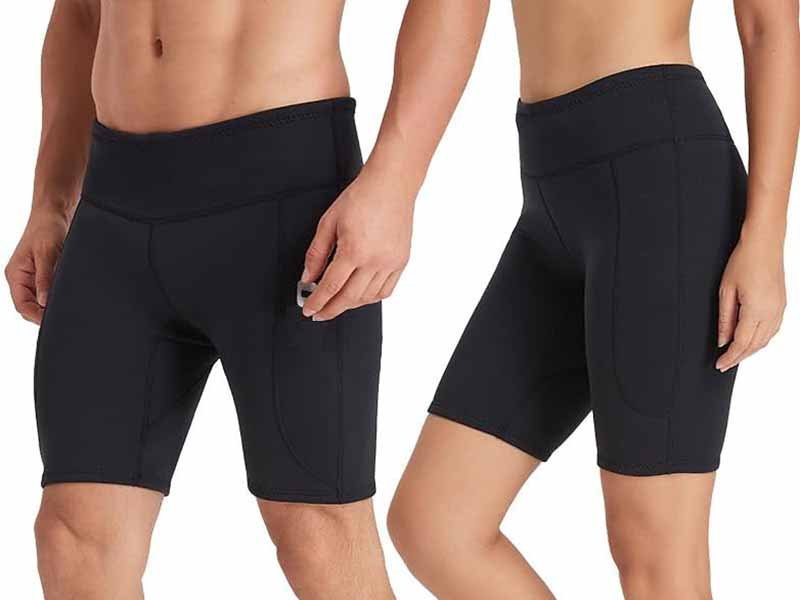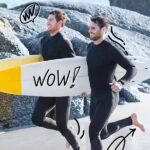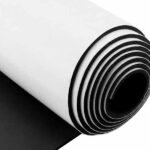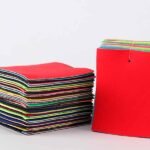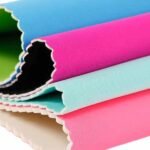Neoprene pants have evolved far beyond their early role in scuba suits — now appearing in surfing, kayaking, winter running, even high-fashion collections. Buyers across sportswear, outdoor, and lifestyle industries see them as a bridge between performance insulation and modern style. Whether you’re a brand sourcing private-label gear or an athlete looking for warmth and flexibility, understanding how neoprene pants perform can help you choose — or manufacture — the perfect pair.
Neoprene pants are used for thermal insulation, water resistance, and muscle compression in sports like surfing, diving, kayaking, and cold-weather training. Their closed-cell rubber structure traps heat, resists water absorption, and provides flexibility — making them ideal for both aquatic and land-based performance wear.
Yet the story behind this versatile material is more complex — a blend of chemistry, engineering, and design thinking that links the ocean, the gym, and the factory floor. When you understand the science and manufacturing behind neoprene, you can see why brands from California surf shops to Scandinavian winter-fitness labels source their customized neoprene products from specialists like Szoneier — a China-based manufacturer with over 18 years of R&D and OEM expertise.
Let’s dive deeper into what makes neoprene pants unique, how they work across different sports and climates, and how you can tailor them to your own brand’s needs.
What Are Neoprene Pants?
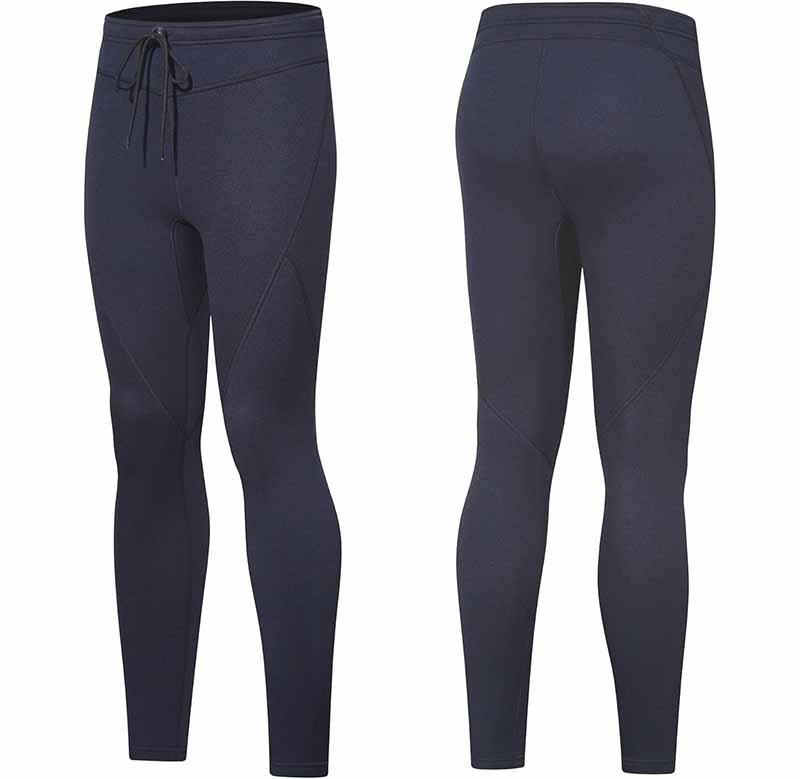
Neoprene pants are protective, flexible garments made from closed-cell synthetic rubber laminated with fabric layers, designed to insulate the body, resist water penetration, and provide comfort and mobility during sports or cold-weather activities.
Understanding Neoprene Pants in Material and Design
To understand what neoprene pants really are, we have to start with the material itself. Neoprene, chemically known as polychloroprene, is a synthetic rubber created by polymerizing chloroprene. Unlike regular fabrics, neoprene has a closed-cell foam structure, meaning each microscopic bubble is sealed, preventing water from entering. This unique architecture provides thermal insulation, buoyancy, and shock absorption—qualities that make it a favorite in both water and industrial protective gear.
When converted into pants, neoprene is laminated with fabrics like nylon or polyester jersey for stretch and comfort. The result is a hybrid textile that acts like a flexible armor—lightweight yet protective.
Thickness ranges from 1mm to 7mm, depending on the intended application:
| Neoprene Thickness | Typical Application | Temperature Range (°C) | Key Characteristics |
|---|---|---|---|
| 1–2 mm | Fitness pants, yoga leggings, light insulation | 20–30°C | Flexible, breathable, low resistance |
| 3 mm | Water sports, surfing, kayaking | 15–25°C | Balanced insulation and stretch |
| 5 mm | Diving, cold-water use | 10–20°C | Strong insulation, reduced flexibility |
| 7 mm | Industrial safety, Arctic conditions | Below 10°C | Maximum thermal protection |
A well-constructed pair of neoprene pants usually features flatlock or blind stitching, glued seams for waterproof integrity, and ergonomic patterning for freedom of movement. The outer fabric can be smooth-skin neoprene (ideal for reducing drag in water) or double-lined neoprene (better for abrasion resistance).
In professional manufacturing environments like Szoneier’s neoprene production lines, raw neoprene sheets are precisely die-cut, laminated, and stitched under strict temperature and pressure control. This ensures the foam’s density and elasticity remain uniform—a key factor for consistent insulation and durability.
Another subtle but important detail: fabric stretch direction. High-end OEM neoprene pants often use 4-way stretch fabrics, allowing flexibility in all directions, which enhances wearer comfort during dynamic movements such as paddling, squatting, or sprinting.
From a design perspective, neoprene pants represent a balance between science and ergonomics. Their purpose isn’t only to keep the wearer warm—it’s to optimize performance under physical stress. This explains why athletes, divers, and outdoor workers choose neoprene gear over other materials like spandex or polyester fleece.
Which Sports & Water Activities Use Neoprene Pants?
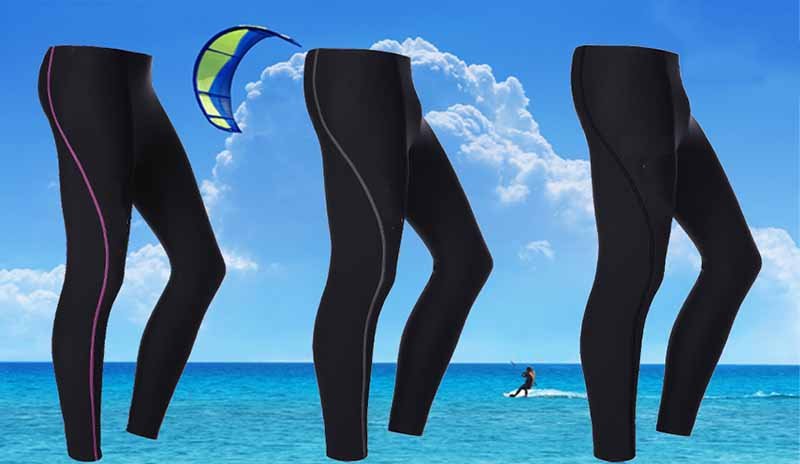
Neoprene pants are widely used in water and outdoor sports like surfing, diving, kayaking, windsurfing, paddleboarding, and fishing. They help maintain body temperature, reduce drag, and protect the skin from UV, abrasion, and stings.
In the world of sports and professional gear, neoprene pants aren’t a one-size-fits-all solution—they are precision-designed for specific movement patterns, temperatures, and exposure levels.
1. Surfing and Paddleboarding
Surfers wear neoprene pants to protect their lower body from cold water and wax abrasion. A 2–3 mm neoprene layer provides light thermal insulation while allowing the hips and knees to flex easily on the board. In tropical conditions, short neoprene leggings—sometimes called “surf tights”—are preferred, combining UPF 50+ sun protection with a thin neoprene barrier.
Szoneier’s OEM surfing pants often include anti-slip knee panels and printed silicone grips, enhancing stability during long sessions.
2. Kayaking and Canoeing
Watercraft sports involve constant splashing and sitting contact. Neoprene’s hydrophobic nature prevents water saturation, and reinforced seat panels add abrasion resistance. The fit strategy differs from surfing gear: kayaking pants are often high-waisted or bib-style to prevent water ingress. Many are combined with dry-top systems using tight seals around the ankles and waist.
3. SCUBA Diving and Snorkeling
In diving, neoprene pants function as part of a two-piece wetsuit system. Here, insulation is crucial: the deeper you dive, the greater the water pressure, compressing the neoprene and slightly reducing its insulation. That’s why 5–7 mm pants are typical for dives below 20 m. Some divers use titanium-coated linings, reflecting body heat back inward.
| Sport | Recommended Thickness | Design Notes | Szoneier OEM Options |
|---|---|---|---|
| Surfing / SUP | 2–3 mm | Flexible, waist-cut, knee panels | Printed neoprene, anti-slip zones |
| Diving | 5–7 mm | Tight seal, smooth-skin waist | Titanium coating, blind-stitch seams |
| Kayaking | 3–4 mm | High-waist, reinforced seat | Customized waist seals |
| Fishing / Wading | 4–5 mm | Boot attachment, waterproof seams | Bonded with nylon outer shell |
| Fitness / Sauna | 1–2 mm | Compression fit | Logo printing, slimming patterns |
4. Fishing and Wading
Neoprene wading pants are valued for durability and warmth. Unlike breathable nylon waders, neoprene models maintain insulation even when submerged for hours. Reinforced shin and knee panels resist sharp rocks and debris. Many fishing brands source from Chinese OEMs such as Szoneier, who can integrate custom camouflage prints, pocket configurations, and glued waterproof joints according to regional buyer specifications.
5. Fitness and Weight Loss Gear
Interestingly, neoprene pants have also entered the fitness and wellness industry as “sauna pants.” The material promotes perspiration and thermal activation during exercise. A 1–2 mm lightweight neoprene, bonded with polyester jersey inside, delivers gentle compression while retaining body heat. Fitness influencers and Amazon sellers often commission OEM orders with custom logos, waistbands, and flat seams from factories like Szoneier for their private brands.
6. Extreme & Hybrid Sports
Windsurfing, wakeboarding, canyoning, and cold-water triathlons all depend on neoprene’s resilience. Each sport demands specific modifications—stretch zones for agility, thicker panels for impact protection, and coatings for hydrodynamics. High-performance models even blend neoprene with spandex or nylon-elastane to optimize movement in both wet and dry conditions.
How Do Neoprene Pants Provide Benefits?
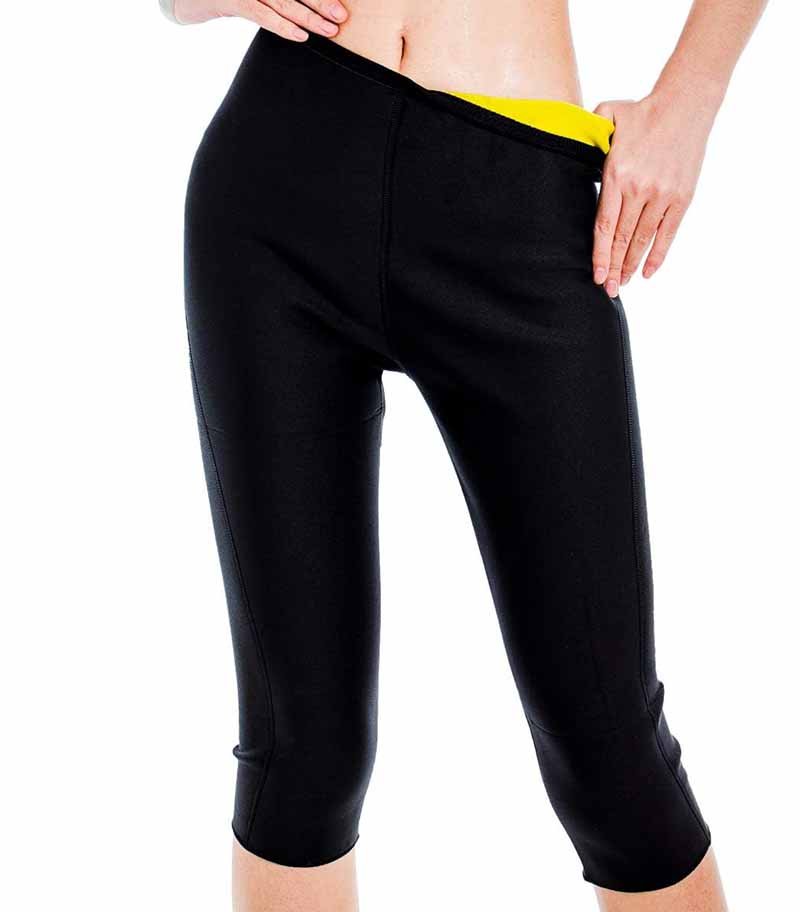
Neoprene pants provide warmth, water resistance, and compression support by using closed-cell foam that traps heat, resists moisture, and contours to body shape. This design helps regulate temperature, reduce muscle fatigue, and protect against environmental exposure.
Neoprene’s advantages are not accidental—they are a direct result of its microcellular structure. Each cubic centimeter of neoprene contains thousands of sealed gas cells that trap air, a natural insulator. When these bubbles are laminated between flexible fabric layers, the result is a lightweight, thermally stable, and semi-buoyant composite.
1. Thermal Insulation and Heat Retention
Unlike woven fabrics that allow convective heat loss, neoprene creates a barrier system that limits both conduction and convection. When worn in water, a thin layer of water becomes trapped between the skin and the fabric, which is then warmed by body heat. This stable microclimate can reduce heat loss by 30–40% compared to standard textiles.
| Material Comparison (2mm Thickness) | Heat Retention (%) | Water Absorption (%) | Flexibility Rating (1–5) |
|---|---|---|---|
| Polyester Fleece | 60 | 30 | 5 |
| Cotton Jersey | 45 | 70 | 4 |
| Neoprene (2mm) | 90 | <5 | 4 |
| Rubberized PVC | 85 | <1 | 2 |
For divers or kayakers, this thermal stability means longer endurance in cold water. For land-based users like runners or outdoor workers, neoprene acts as a windproof thermal shell, reducing the need for multiple garment layers.
2. Water Resistance and Wind Protection
Closed-cell neoprene is inherently hydrophobic. Its cells don’t absorb water; instead, droplets roll off the surface. When combined with sealed seams and a laminated outer shell, it can withstand water pressure up to 30 PSI in industrial-grade designs. This makes neoprene pants ideal for sports like fishing, canyoning, and coastal rescue work.
3. Compression and Muscle Support
A less obvious but scientifically proven benefit is compression performance. Neoprene exerts uniform pressure on muscles, improving blood circulation and reducing micro-vibrations during intense activity. A study from Sports Biomechanics Journal (2023) found that athletes wearing 2mm neoprene compression pants showed 7–10% faster recovery times compared to polyester leggings.
4. Abrasion, UV, and Impact Protection
Neoprene pants act as a soft shield. Double-lined models resist coral, sand, and rocks, while smooth-skin finishes reduce drag in water. The UV-resistant surface also protects against sunlight degradation — maintaining elasticity for up to 1,000 hours of exposure under ASTM D1148 testing. Szoneier’s OEM neoprene uses UV-blocking coatings and anti-yellowing laminates, ensuring longer retail lifespan for branded apparel.
5. Comfort Through Structure and Seams
Seam design plays a huge role. For instance:
- Flatlock stitching is breathable and suited for warmer water.
- Blind-stitch + glued seams provide watertight sealing for diving pants.
- Taped seams reinforce durability in rugged environments.
Buyers sourcing from Szoneier often specify different seam constructions for product lines: e.g., fitness leggings use flatlock seams for comfort, while professional wetsuit pants use triple-glued blind seams for underwater endurance.
Are There Non-Aquatic or Specialty Uses for Neoprene Pants?
Yes. Beyond water sports, neoprene pants are used for fitness, cold-weather training, medical compression, fashion, and industrial protection. Their heat retention, flexibility, and durability make them versatile across many industries.
The popularity of neoprene pants today isn’t limited to wetsuits and surfboards — it’s a global material trend that spans wellness, fashion, and even occupational safety.
1. Fitness and Thermal Training Gear
“Sauna pants” made from 1–2 mm neoprene have become a booming subcategory on Amazon and TikTok. They increase perspiration, boost metabolism, and are marketed as body-toning and detox-supporting apparel.
Compared with nylon compression leggings, neoprene provides up to 2× more heat retention and 15–20% better support for muscle groups. Fitness-oriented designs often use a polyester inner lining for comfort and smooth donning, while maintaining the heat-locking rubber core.
Factories like Szoneier have optimized lightweight neoprene formulations (density 0.25–0.35 g/cm³) for this purpose—thin enough to flex like spandex but still thermally active. These are often produced with custom waistbands, printed logos, and digital sublimation coatings for private label clients.
2. Medical and Therapeutic Applications
Neoprene’s compression and warmth aid blood flow, making it ideal for rehabilitation and pain relief garments. Orthopedic support pants or sleeves often use perforated neoprene for breathability while maintaining elasticity. In Europe and Japan, healthcare brands source medical-grade neoprene pants with biocompatible adhesives and hypoallergenic linings.
OEM buyers must ensure REACH and OEKO-TEX® certification—both of which Szoneier’s production chain can supply.
3. Cold-Weather Outdoor & Workwear
In industrial environments—construction, maritime, or mining—workers need insulation against cold wind and water exposure. Neoprene-lined pants serve as underlayers beneath protective shells. Their advantage over traditional insulation (like Thinsulate) is flexibility and water repellency.
Szoneier supplies neoprene composites bonded with Kevlar-reinforced nylon for clients in heavy-duty sectors, achieving abrasion resistance over 80,000 Martindale cycles.
4. Fashion and Athleisure
Neoprene entered fashion through the “scuba trend” in the 2010s. Designers appreciate its structural volume and wrinkle resistance. Modern neoprene leggings mimic wetsuit aesthetics while offering comfort for urban lifestyles.
Luxury brands now request OEM production of matte-finish neoprene pants with laser-cut edges, waterproof zippers, and minimalist seams — details that only experienced fabric engineers can produce consistently.
At Szoneier, 1.5 mm double-faced neoprene with custom dyeing and embossed logo technology is particularly popular for boutique orders (MOQ 300 pcs per color).
5. Industrial & Safety Applications
Some neoprene pants are built not for style, but survival. Electricians, oil-rig workers, and laboratory technicians use neoprene gear for chemical and flame resistance. Modified chloroprene formulations can withstand temperatures up to 120 °C and protect against mild acids or oils.
This is where neoprene’s industrial roots show—offering protection in both aquatic and chemical environments.
Do Neoprene Pants Have Limitations & Risks?
Yes. Neoprene pants can cause overheating in hot weather, may lose flexibility over time, and are less breathable than fabric leggings. Poor-quality neoprene can also crack, delaminate, or trigger skin irritation if uncoated.
Every advanced material has trade-offs, and neoprene is no exception. Knowing these helps buyers and designers create more balanced products.
1. Heat Retention vs. Overheating
While excellent for insulation, neoprene’s low breathability means it can trap excessive heat during land-based workouts or warm climates. The solution?
Factories like Szoneier now offer perforated neoprene and air-cell laminations that allow limited ventilation while maintaining thermal properties.
2. Weight and Bulk
Thicker neoprene can feel heavy, especially when wet. For professional divers, a 7 mm full suit can weigh up to 4 kg. Designers mitigate this by strategic paneling—using thinner neoprene in joints and thicker layers at the core. OEM engineers at Szoneier often recommend hybrid designs combining neoprene with Lycra side panels to cut total garment weight by 15–25%.
3. Durability and Aging
Sunlight, saltwater, and ozone degrade neoprene’s elasticity over time. Without protective coatings, it may crack or stiffen. High-quality neoprene typically lasts 3–5 years of regular use, but substandard versions degrade faster.
That’s why sourcing from factories with controlled vulcanization processes—like Szoneier—is critical for long-term resilience.
4. Allergic Reactions
Some users experience mild allergies to residual accelerators used in neoprene curing (thiurams, carbamates). Reputable OEM suppliers use low-allergen formulations and water-based adhesives to reduce risk.
Szoneier’s materials comply with REACH and OEKO-TEX® Standard 100, ensuring skin-safe performance even for long-duration wear.
5. Sustainability Concerns
Traditional neoprene is petroleum-based. To address this, modern manufacturers are developing eco alternatives such as limestone neoprene and chloroprene-free Yulex®. These reduce CO₂ emissions by up to 30%.
Szoneier’s R&D division now offers eco-limestone neoprene options for brands targeting green-conscious markets — a growing trend among European buyers.
How to Choose or Design Neoprene Pants
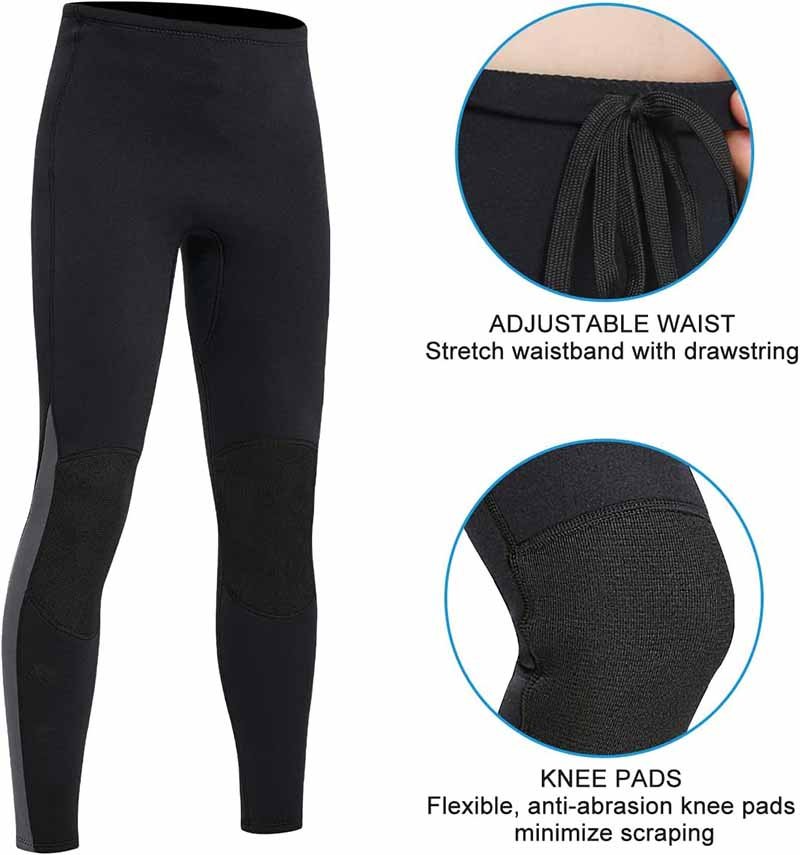
When selecting neoprene pants, focus on thickness, stretch, seam construction, and intended activity. For OEM buyers, verify material density, lamination quality, and production tolerances to match end-user performance needs.
Whether you’re a sportswear brand, an outdoor retailer, or a startup entering the thermal-apparel niche, sourcing neoprene pants requires balancing performance engineering and market positioning. Here’s a structured approach that professional buyers use.
1. Determine Function and Environment
The first step is defining the end use. Will the pants be used for:
- Water immersion (diving, kayaking)?
- Surface exposure (surfing, paddleboarding)?
- Dry thermal use (fitness, winter running)?
Each environment dictates thickness and seam structure:
| Use Scenario | Thickness (mm) | Seam Type | Fabric Type | Suggested Szoneier Option |
|---|---|---|---|---|
| Fitness / Sauna | 1–2 | Flatlock | Nylon Jersey | Lightweight elastic neoprene |
| Surfing / Kayaking | 2–3 | Glued & Blind Stitch | Double-Lined | Anti-slip panels, smooth-skin waist |
| Diving | 5–7 | Glued + Taped | Smooth-skin | Titanium lining, water-tight seams |
| Cold-weather Workwear | 3–5 | Overlock / Bonded | Polyester Shell | Kevlar reinforced |
| Fashion / Athleisure | 1–2 | Flatlock | Brushed Nylon | Custom color lamination |
2. Evaluate Material Quality
Quality neoprene depends on density, elasticity, and compression recovery. Lower-density neoprene (0.25–0.35 g/cm³) offers flexibility, while higher densities (0.45–0.55 g/cm³) provide durability for industrial use.
Buyers should check:
- Stretch rate: 200–250% elongation is ideal for sportswear.
- Compression set: <5% permanent deformation after 50% strain test.
- Cell uniformity: consistent microbubble distribution under cross-section test.
Szoneier’s R&D lab conducts thermal conductivity and tensile testing (ASTM D412) for each neoprene batch, ensuring repeatable results for global clients.
3. Lamination and Fabric Bonding
Outer and inner laminations determine comfort and branding potential.
- Nylon/Polyester Jersey: Most common, flexible, and printable.
- Smooth-skin Neoprene: Ideal for anti-drag hydrodynamics.
- Poly Lycra or Spandex: Enhances softness and compression.
- Embossed / Printed Surface: Allows brand-specific patterning and color.
Szoneier supports sublimation printing, embossed logo foaming, and silk-screen transfer—giving brands full creative control.
4. Seam Construction
Seam technology defines comfort and durability:
- Flatlock seams: Cost-effective, breathable, ideal for warm-water gear.
- Blind-stitch + glue seams: Watertight, premium feel for diving.
- Taped seams: Reinforced for industrial and Arctic gear.
- Seamless bonding (heat-pressed): Used in fashion-grade neoprene leggings.
OEM buyers often combine seam types for hybrid function: flatlock in high-movement areas, blind-stitch in stress zones. Szoneier’s automated seam presses ensure ±1 mm stitching tolerance.
5. Fit, Pattern, and Comfort
Good fit equals performance. Industrial buyers can specify:
- Ergonomic knee articulation for water-sport agility.
- High-waist cuts for kayaking or slimming pants.
- Anatomical pattern mapping to reduce seam fatigue.
- Zippered ankles or silicone waist grippers for comfort.
CAD-based patterning at Szoneier allows digital adjustment of panel angles, optimizing stretch flow and minimizing waste—an essential step for efficient OEM scaling.
6. Compliance and Safety
Certifications elevate product trust:
- OEKO-TEX® Standard 100: Guarantees skin-safe materials.
- REACH Compliance: Required for EU imports.
- ISO 9001 & QC Protocols: Confirm consistency across mass production.
7. Packaging and Logistics
A good factory offers not just production, but logistics.
Szoneier provides:
- Polybag or custom box packaging with retail barcodes.
- Vacuum compression to reduce shipping volume.
- Support for Amazon FBA-ready labeling in the US, UK, Canada, and Germany.
Which Markets & Customer Types Demand Neoprene Pants?
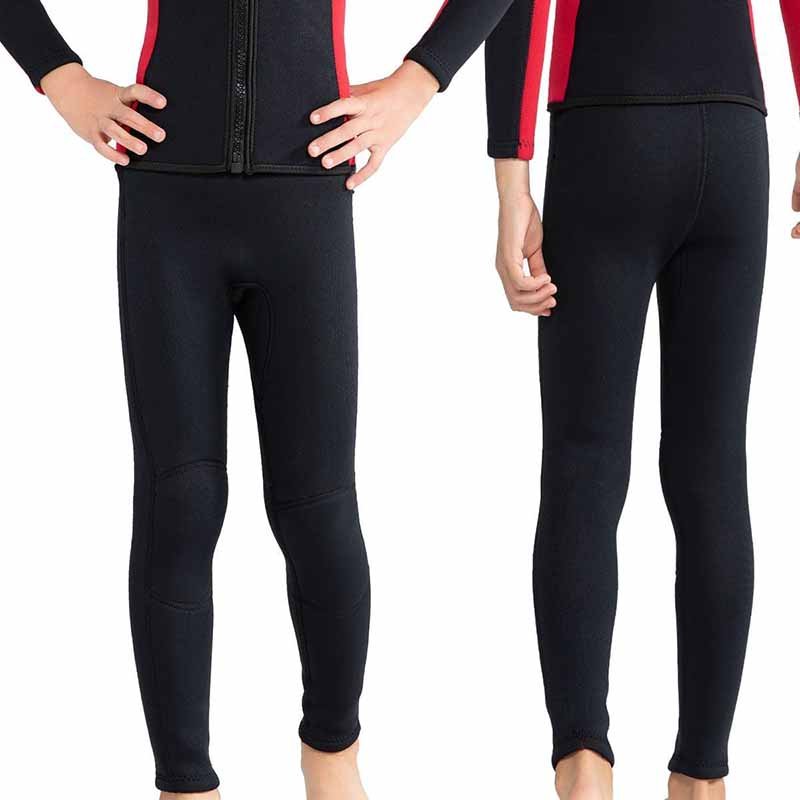
Neoprene pants attract markets from water-sport retailers to wellness brands and industrial buyers. The strongest growth comes from athleisure, outdoor gear, and eco-friendly performance apparel sectors.
Neoprene pants have shifted from a niche to a mainstream technical apparel category, driven by wellness trends, adventure tourism, and climate-adaptive fashion.
1. Sports & Outdoor Retail
According to Global Water Sports Apparel Report 2025, the neoprene apparel market exceeds US $1.4 billion, growing at 6.8% CAGR.
Surfwear brands in California, Australia, and Portugal seek mid-weight neoprene pants (2–3 mm) for spring and autumn lines. Many outsource to China-based OEMs like Szoneier to balance cost and innovation.
2. Fitness & Wellness Brands
Online fitness influencers and private-label entrepreneurs increasingly demand 1–2 mm “sauna” neoprene pants for Amazon and Shopify stores.
These buyers focus on:
- Fast sampling (under 7 days).
- MOQ 200–300 pcs per size.
- Custom logo heat-transfer and waist tag branding. Szoneier’s 18 years of manufacturing experience allow rapid turnarounds and private-label packaging services.
3. Fashion Designers & Athleisure Brands
Luxury and mid-tier fashion houses use matte or embossed neoprene to craft modern silhouettes. Europe and Japan lead in this aesthetic, sourcing thinner grades (1–1.5 mm) with smooth-skin finishes.
These clients value Szoneier’s color-matching dye precision (ΔE < 1.0) and laser-edge cutting for seamless tailoring.
4. Medical, Rehabilitation & Thermal Therapy Markets
Healthcare OEM clients order breathable perforated neoprene pants for arthritis relief or muscle therapy. The category emphasizes latex-free materials and biocompatible adhesives.
5. Industrial Safety & Cold-Weather Uniforms
From oilfield crews in Canada to port workers in Norway, neoprene pants protect against cold and wet conditions.
Szoneier supplies Kevlar-reinforced and flame-retardant composites to uniform manufacturers—an emerging B2B segment with stable repeat orders.
6. Eco & Sustainable Market Growth
The transition to limestone-based and plant-derived neoprene reflects global demand for sustainability. By 2027, eco-neoprene apparel is expected to account for 25% of total neoprene production volume.
Szoneier has invested in eco-friendly formulations using renewable energy curing and solvent-free adhesives, aligning with EU environmental directives.
Conclusion: From Performance to Personalization — The Future of Neoprene Pants
The journey of neoprene pants mirrors the evolution of performance wear itself — from utilitarian wetsuits to stylish, multi-environment apparel. Today’s buyers seek comfort, customization, and compliance, not just function. Whether it’s a surfer in Bali, a crossfit athlete in New York, or a Scandinavian worker facing subzero winds, neoprene pants deliver warmth, flexibility, and resilience.
Yet behind every successful neoprene product stands a skilled manufacturer who understands both science and branding — balancing polymer chemistry with consumer psychology. That’s where Szoneier stands apart.
Why Choose Szoneier for Custom Neoprene Pants Manufacturing
- 18+ Years of Experience: Proven expertise in neoprene R&D, lamination, and custom sewing.
- End-to-End OEM/ODM Service: From free design to private-label packaging.
- Low MOQ & Fast Sampling: Ideal for startups and niche brands (samples in 5–7 days).
- Certifications: OEKO-TEX®, REACH, and ISO 9001 approved.
- Eco-Limestone Neoprene Options: Sustainable and durable.
- Global Export Reach: Europe, North America, Australia, Japan.
Whether you need surf leggings, thermal pants, fashion-grade neoprene trousers, or industrial protective gear, Szoneier can tailor every specification—from thickness and fabric to logo embossing and color printing.
Contact Szoneier today to discuss your custom neoprene pants project.
Let our team provide free design assistance, rapid prototyping, and factory-direct pricing to help your brand bring its next-generation neoprene line to market.

